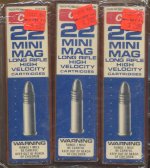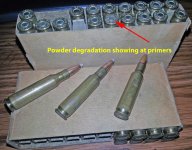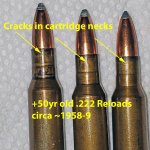BillBro
Member
I know alot of people say this is a stupid, wasteful and unnecessary step in the process of crafting our own ammo but I do do it for rounds I intend to load for long term storage, ammo stored at our camp or something I might load for a special hunting trip depending on the location and climate.
I think the most popular commercial product used by many including myself is Marcron but it always seemed very expensive to me considering what it is , basically nail polish as far as I can tell. I havent bought or used any in a very long time but have used it many times.
A friend and myself, who I discovered has a camp in WV not too far from my place ( its walkable, might take a few days but definitely walkable) decided to load up some ammo just to squirrel away in these uncertain times and he brought up the sealing of it. He was ready to order the Marcron and I told him to hold off until we could look around and see what was currently available to us, bound to be some new products out there by now right? Well, not many as it turns out but I did find something called Ranger. It's on Amazon, I know, hard to believe isnt it. Yes, Amazon, they have everything. This sealant comes in several different very vibrant colors like red, blue, dark and light green, orange and purple I think. Says your ammo can be fully submerged for 6 months, says it's easy to apply, dries in about 5 minutes and a $29 bottle is enough to do something like 30,000 primers.
OK, I'll bite. Ordered a bottle of the red and did up every round I loaded after getting it in the mail about a month later, comes from the Czech Republic I think it was. It is indeed easy to apply. They send a small brush with it but that was wasting too much product and it was aesthetically offensive. I took a snippet of a metal clothes hanger and sharpened one end to a long fine point, makes a perfect pinpoint applicator. Dip it in the bottle, the liquid runs down and forms a droplet at the point tip, touch your round where you want to seal it and this stuff very rapidly will run completely around a primer or a casemouth/bullet and I did both, sealed the primers and the case/bullet junction of about 3,000 5.56 rounds and I couldn't tell you how many pistol rounds and still have over 2/3 of the bottle left.
It does indeed dry in about 5 minutes but if you blow ever so gently on say, a drop that might have been too big and it's running a little it will congeal before your eyes. It's very easy to apply and you'll soon get the hang of how deep to dip your applicator for the perfect amount for a primer or vase mouth.
I guess you could say it creeps very well too, like Kroil does and just sucks right into the smallest crevice.
I dont know about submerged for 6 months or whatever they claimed but 1 month, definitely. I took a handful of 5.56 rounds I loaded and put them in a big plastic bowl that I kept topped off with water and after 1 month took them out, dried them off and shot them and they all went bang, bang, bang...
Seems like a decent product if anyone is interested in this sort of thing.
I think the most popular commercial product used by many including myself is Marcron but it always seemed very expensive to me considering what it is , basically nail polish as far as I can tell. I havent bought or used any in a very long time but have used it many times.
A friend and myself, who I discovered has a camp in WV not too far from my place ( its walkable, might take a few days but definitely walkable) decided to load up some ammo just to squirrel away in these uncertain times and he brought up the sealing of it. He was ready to order the Marcron and I told him to hold off until we could look around and see what was currently available to us, bound to be some new products out there by now right? Well, not many as it turns out but I did find something called Ranger. It's on Amazon, I know, hard to believe isnt it. Yes, Amazon, they have everything. This sealant comes in several different very vibrant colors like red, blue, dark and light green, orange and purple I think. Says your ammo can be fully submerged for 6 months, says it's easy to apply, dries in about 5 minutes and a $29 bottle is enough to do something like 30,000 primers.
OK, I'll bite. Ordered a bottle of the red and did up every round I loaded after getting it in the mail about a month later, comes from the Czech Republic I think it was. It is indeed easy to apply. They send a small brush with it but that was wasting too much product and it was aesthetically offensive. I took a snippet of a metal clothes hanger and sharpened one end to a long fine point, makes a perfect pinpoint applicator. Dip it in the bottle, the liquid runs down and forms a droplet at the point tip, touch your round where you want to seal it and this stuff very rapidly will run completely around a primer or a casemouth/bullet and I did both, sealed the primers and the case/bullet junction of about 3,000 5.56 rounds and I couldn't tell you how many pistol rounds and still have over 2/3 of the bottle left.
It does indeed dry in about 5 minutes but if you blow ever so gently on say, a drop that might have been too big and it's running a little it will congeal before your eyes. It's very easy to apply and you'll soon get the hang of how deep to dip your applicator for the perfect amount for a primer or vase mouth.
I guess you could say it creeps very well too, like Kroil does and just sucks right into the smallest crevice.
I dont know about submerged for 6 months or whatever they claimed but 1 month, definitely. I took a handful of 5.56 rounds I loaded and put them in a big plastic bowl that I kept topped off with water and after 1 month took them out, dried them off and shot them and they all went bang, bang, bang...
Seems like a decent product if anyone is interested in this sort of thing.



